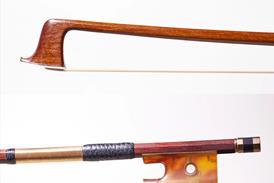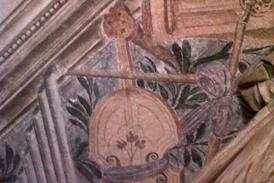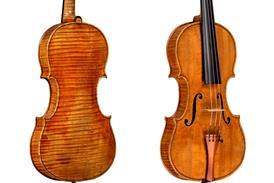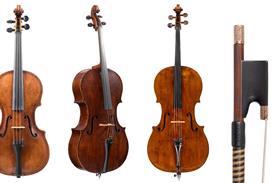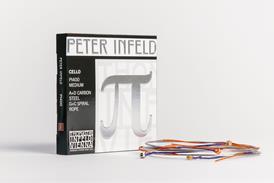All Lutherie articles – Page 39
-

-
 Premium ❘ Feature
Premium ❘ FeatureSartory and the fake bows: Phoney war
One of France’s greatest bow makers,Eugène Sartory sued an unscrupulous American dealer who flooded the market with fake bows. Using the original court transcripts and contemporary news reports, Gennady Filimonov uncovers how the Frenchman sought justice
-
 Premium ❘ Feature
Premium ❘ FeatureJacques-Pierre Thibout: violins fit for a king
One of the key Parisian luthiers of the early 19th century, Jacques-Pierre Thibout had a distinctive – and often innovative – making style. Florent and Serge Boyer examine ten of his violins to track its evolution, and show why he became luthier to King Louis-Philippe
-
 News
NewsTop lots from the October London stringed instrument auctions
Old Italians and a modern bow proved popular at this autumn’s auctions, as Kevin MacDonald reports
-
 Premium ❘ Focus
Premium ❘ FocusTrade secrets: An innovative method of neck setting
Gluing the neck to the ribs before the top and back plates allows for a more accurate and hassle-free process. By Hayato Nagaishi, luthier based in Cremona, Italy, and Tokyo, Japan
-
 Premium ❘ Feature
Premium ❘ FeaturePressenda: Combined impact
Despite his instruments showing very little difference in form, Giovanni Francesco Pressenda was one of the most idiosyncratic – and innovative – Italian luthiers of the 19th century. Drawing on 20 years of research, Tsutomu Miyasaka reveals how his style reflected both the French and Italian makers of his day
-
 Premium ❘ Focus
Premium ❘ FocusIn focus: a 1972 violin by Alfredo del Lungo
Alfredo Del Lungo began studying the art of violin making at the workshop of his father, Giuseppe Del Lungo (1883–1926), while also taking cello lessons at the Conservatorio Cherubini in Florence. In 1933, aged 24, he was appointed official luthier to the Stabile Orchestrale Fiorentina, which soon became the Orchestra ...
-
 Premium ❘ Feature
Premium ❘ FeatureFingerboards: The lighter option
While the acoustics of the violin soundbox have undergone rigorous testing, the neck and fingerboard have been virtually ignored. Joseph Nagyvary reveals the results of experiments showing that a lighter material might be preferable to the standard ebony
-
 Premium ❘ Article
Premium ❘ ArticleTrade secrets: making and fitting purfling
A solution to the awkward problem of how to insert strips around the neck heel area, by Hans Pluhar
-
 Premium ❘ Article
Premium ❘ ArticleIn focus: Paul Dörfel
A 1920 violin made by the Markneukirchen-based luthier Paul Dörfel. Written by Bruce Babbitt
-
 Premium ❘ Feature
Premium ❘ FeaturePersoit, the illusion solution
One of the most mysterious French bow makers, Persoit had a number of idiosyncrasies that give his works a uniquely light appearance. Through a detailed study of a single bow, Paolo Sarri shows his creative answer to the problem of bulky heads
-
 Premium ❘ Feature
Premium ❘ FeatureAt the dawn of it all: making in Füssen
Nowadays best known for its neo-Gothic castles, the town of Füssen in southern Germany has possibly the oldest lutherie tradition of any in the country. Thomas Riedmillertraces its influence, from the foothills of the Alps to England, Vienna and Prague
-
 Premium ❘ Feature
Premium ❘ FeatureVuillaume's Early Years: The Making of a Master
Jean-Baptiste Vuillaume was the most successful French luthier of his time, but the first years of his career are still shrouded in mystery. Jonathan Marolle examines some of his earliest instruments to uncover the evolution of his technique and style
-
 Premium ❘ Feature
Premium ❘ FeatureMichel Collichon: The Magnificent Ten
Just a handful of instruments by Michel Collichon have survived to the present day – but they demonstrate the skill and techniques of a master innovator. With a tenth example recently identified, Shem Mackey explains the appeal of the 17th-century viol maker to modern-day luthiers
-
 Premium ❘ Feature
Premium ❘ FeatureJacob Stainer: reviewing the situation
It has long been assumed that Jacob Stainer received some training in Cremona – but the theory rests on slim evidence. Rudolf Hopfner explores a middle-period violin using micro-CT technology to cast doubt on what we think we knowWolfgang Schneiderhan
-
 Premium ❘ Article
Premium ❘ ArticleTrade secrets: cutting f-holes
A methodical way of completing this elegant but delicate part of the making process by WILLIAM CASTLE, luthier based in Whitchurch, Shropshire, UK
-
 Premium ❘ Article
Premium ❘ ArticleIn focus: a 1937 violin by Paolo De Barbieri
Paolo De Barbieri was born in 1889 in Genoa. In 1902, aged 13, he left a note on the kitchen table which read ‘Back in a minute’: he left home for about six years to work as a cabin boy. He completed his military service in the navy and in ...
-
 Premium ❘ Feature
Premium ❘ FeatureVarnish analysis: shining examples
Identifying the varnish recipes of the early makers has been a long-held dream among researchers. Now, a team at the Arvedi Laboratory of Non-Invasive Diagnostics, headed by Marco Malagodi, has used a new form of micro-CT scanning to delve further into an instrument’s coatings than ever before
-
 Premium ❘ Feature
Premium ❘ FeatureStradivari’s moulds: Variations on a theme
Twelve violin moulds from Antonio Stradivari’s workshop still survive, but how do they correspond to the master’s oeuvre? In the first of two articles,Philip Ihle and Andrea Zanrè present the results of an exhaustive survey to match forms to finished instruments
-
 Premium ❘ Feature
Premium ❘ FeatureStradivari’s corners: Music of the spheres
The publication of high-accuracy violin photography has opened up new possibilities for researching Cremonese masterpieces up close and en masse. Philip Ihle examines Antonio Stradivari’s purfling corners across 136 examples and reveals their relationship with the luthier’s forms





